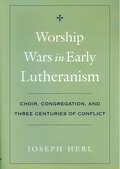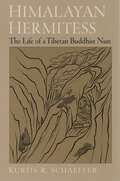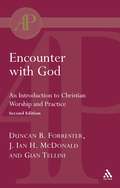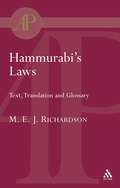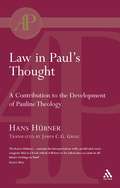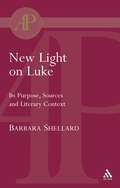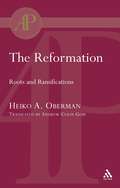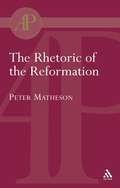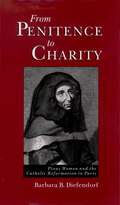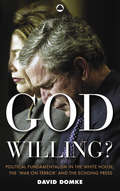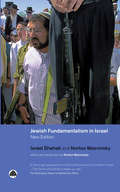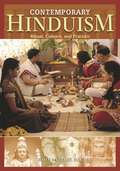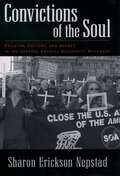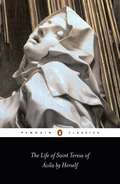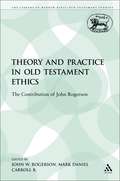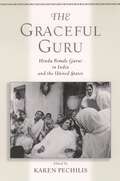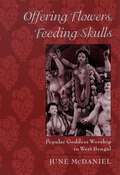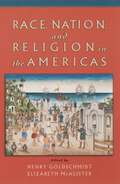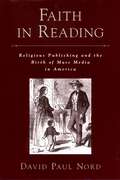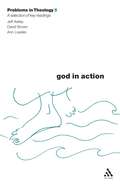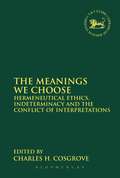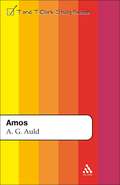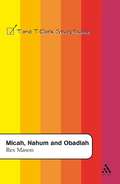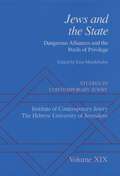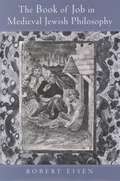- Table View
- List View
Worship Wars in Early Lutheranism: Choir, Congregation, and Three Centuries of Conflict
by Joseph HerlHow important was music to Martin Luther? Drawing on hundreds of liturgical documents, contemporary accounts of services, books on church music, and other sources, Joseph Herl rewrites the history of music and congregational song in German Lutheran churches. Herl traces the path of music and congregational song in the Lutheran church from the Reformation to 1800, to show how it acquired its reputation as the "singing church." In the centuries after its founding, in a debate that was to have a strong impact on Johann Sebastian Bach and his contemporaries, the Lutheran church was torn over a new style of church music that many found more entertaining than devotional. By the end of the eighteenth century, Lutherans were trying to hold their own against a new secularism, and many members of the clergy favored wholesale revision or even abandonment of the historic liturgy in order to make worship more relevant in contemporary society. Herl paints a vivid picture of these developments, using as a backdrop the gradual transition from a choral to a congregational liturgy. The author eschews the usual analyses of musical repertoire and deals instead with events, people and ideas, drawing readers inside the story and helping them sense what it must have been like to attend a Lutheran church in the sixteenth through eighteenth centuries. Parallel developments in Catholic churches are discussed, as are the rise of organ accompaniment of hymns and questions of musical performance practice. Although written with academic precision, the writing is clear and comprehensible to the nonspecialist, and entertaining anecdotes abound. Appendixes include translations of several important historical documents and a set of tables outlining the Lutheran mass as presented in 172 different liturgical orders. The bibliography includes 400 Lutheran church orders and reports of ecclesiastical visitations read by the author.
Himalayan Hermitess: The Life of a Tibetan Buddhist Nun
by Kurtis R. SchaefferHimalayan Hermitess is a vivid account of the life and times of a Buddhist nun living on the borderlands of Tibetan culture. Orgyan Chokyi (1675-1729) spent her life in Dolpo, the highest inhabited region of the Nepal Himalayas. Illiterate and expressly forbidden by her master to write her own life story, Orgyan Chokyi received divine inspiration, defied tradition, and composed one of the most engaging autobiographies of the Tibetan literary tradition. The Life of Orgyan Chokyi is the oldest known autobiography authored by a Tibetan woman, and thus holds a critical place in both Tibetan and Buddhist literature. In it she tells of the sufferings of her youth, the struggle to escape menial labor and become a hermitess, her dreams and visionary experiences, her relationships with other nuns, the painstaking work of contemplative practice, and her hard-won social autonomy and high-mountain solitude. In process it develops a compelling vision of the relation between gender, the body, and suffering from a female Buddhist practitioner's perspective. Part One of Himalayan Hermitess presents a religious history of Orgyan Chokyi's Himalayan world, the Life of Orgyan Chokyi as a work of literature, its portrayal of sorrow and joy, its perspectives on suffering and gender, as well as the diverse religious practices found throughout the work. Part Two offers a full translation of the Life of Orgyan Chokyi. Based almost entirely upon Tibetan documents never before translated, Himalayan Hermitess is an accessible introduction to Buddhism in the premodern Himalayas.
Encounter with God
by Duncan B. Forrester James Ian McDonald Gian TelliniAn ecumenical introduction to the study of Christian worship which emphasises the complimentarity of Word and Sacrament and the unity of theology and practice, and considers the place of worship in the modern age. It is especially designed for those, of various traditions, who are preparing for the ministry or who participate regularly in worship and wish to deepen their understanding.
Hammurabi's Laws: Text, Translation and Glossary
by M. E. RichardsonRichardson supplies a new translation and transcription (which incorporates the most important manuscript variants) of the most famous of all ancient Mesopotamian texts. He also provides a complete lexical analysis of every word that is used in it. The edition covers the prologue and epilogue as well as the laws themselves. Students of the Bible, ancient Near Eastern law and general Semitics are now provided with an indispensable reference tool in a convenient form. The detailed information in the glossary, where the full context of every quotation is given, will also be a tremendous help to those who want to learn or revisit Akkadian.
Law in Paul's Thought (Academic Paperback Ser.)
by Hans HübnerUntil now Paul's theology has been treated in exegetical literature almost exclusively as a systematic ntil now Paul's theology has been treated in exegetical literature almost exclusively as a systematic whole. Here, by contrast, the attempt is made to show how Paul's theology can be adequately understood only when it is seen in relation to its development. There is a decisive process of theological development between Galatians and Romans which in turn must be related to Paul's biography.Law in Paul's Thought examines the relation between Paul's teaching in Galatians and Romans, arguing that there is a major shift in emphasis between the two. An intriguing and concisely argued monograph, it points to a striking discord within Paul's view of the Law and asks whether these differences should not be explained in terms of development in Paul's theology. Hübner skillfully traces the arguments and interconnections between arguments in the different passages, illuminating Paul's theology from law.
New Light on Luke: Its Purpose, Sources and Literary Context (Academic Paperback Ser.)
by Barbara ShellardThis radical new interpretation reveals many connections between Luke and Johannine traditions. Comparision of pericopae shared by Luke and John suggests that the usual assumptions of Lukan priority may be mistaken; instead his may be chronologically the fourth gospel. Luke neverthless treats his sources in different ways, his response being both critical and creative. He aims to give security to Christians by including as much as possible and reconciling conflicting traditions, while firmly excluding heretical misinterpretation.Shellard also includes a consideration of Luke's use of possible sources, both canonical and extra-canonical, and places Luke-Acts in its literary context, noting among other things the presentation of Rome as a facilitatator of evangelization and a promoter of co-existence.This is volume 215 in the Journal for the Study of the New Testament Supplement series.
The Reformation: Roots and Ramifications
by Heiko ObermanIn this wide-ranging volume Heiko Oberman traces threads of continuity flowing to and through the Reformation. Many his most important studies appear here in English for the first time.Professor Oberman explores "experiential" mysticism; the "battle on two fronts" waged by the Wittenburg circle against Pierias and Eck; Luther's medieval and apocalyptical conception of reformatio and its purpose; the pre-history of "confessionalization" in the Confession of Ausburg and its "Confutatio" byt Luther's Roman opponents; Zwingli's plans for a Godly alliance in the southern Germanic ecumene and the destructive tensions between Zwingli and Luther.In the final chapter, Oberman describes a model of three long-term "Reformations" that can also be seen as revolutions: the Concillar Reformation, the City Reformation, and the Calvinist Reformation of the Refugees. The often denied and generally misunderstood "continuities" between theological directions of the later Middle Ages, the theological reformation of the early sixteenth century and subsequent developments are constantly illuminated through exacting detail and compelling insights.
Rhetoric of the Reformation: Rhetoric Of The Reformation
by Peter MathesonPeter Matheson has written the first study in English of the Reformation as a literary phenomenon. This book traces the first emergence of a 'public opinion' in European history. Using insights from social history, religion and literature, Professor Matheson explores the connection between the 'communal Reformation' and the outpouring of pamphlets in the early 1520's. These pamphlets helped create a dynamic and subversive network of communication where language and structure were of equal importance. He also examines the relative strengths of polemical and dialogical approaches in winning adherents, the motivations of the authors, and the expectations of audiences.
From Penitence to Charity: Pious Women and the Catholic Reformation in Paris
by Barbara B. DiefendorfFrom Penitence to Charity radically revises our understanding of women's place in the institutional and spiritual revival known as the Catholic Reformation. Focusing on Paris, where fifty new religious congregations for women were established in as many years, it examines women's active role as founders and patrons of religious communities, as spiritual leaders within these communities, and as organizers of innovative forms of charitable assistance to the poor. Rejecting the too common view that the Catholic Reformation was a male-dominated movement whose principal impact on women was to control and confine them, the book shows how pious women played an instrumental role, working alongside--and sometimes in advance of--male reformers. At the same time, it establishes a new understanding of the chronology and character of France's Catholic Reformation by locating the movement's origins in a penitential spirituality rooted in the agonies of religious war. It argues that a powerful desire to appease the wrath of God through acts of heroic asceticism born of the wars did not subside with peace but, rather, found new outlets in the creation of austere, contemplative convents. Admiration for saintly ascetics prompted new vocations, and convents multiplied, as pious laywomen rushed to fund houses where, enjoying the special rights accorded founders, they might enter the cloister and participate in convent life. Penitential enthusiasm inevitably waned, while new social and economic tensions encouraged women to direct their piety toward different ends. By the 1630s, charitable service was supplanting penitential asceticism as the dominant spiritual mode. Capitalizing on the Council of Trent's call to catechize an ignorant laity, pious women founded innovative new congregations to aid less favored members of their sex and established lay confraternities to serve society's outcasts and the poor. Their efforts to provide war relief during the Fronde in particular deserve recognition.
God Willing?: Political Fundamentalism in the White House, the 'War on Terror' and the Echoing Press
by David DomkeThe political fundamentalism, offered up by the Bush administration after 9/11, capitalised upon the fear felt by many Americans. In essence, it is a conservative-religious ideology, but via strategic communication choices, it was transformed into a policy agenda that feels political rather than religious. These communications dominated public discourse and public opinion for months on end and came at a significant cost for democracy.*BR**BR*The administration had help spreading its messages. The mainstream press consistently echoed the administration's communications - thereby disseminating, reinforcing and embedding the administration's fundamentalist worldview and helping to keep at bay Congress and any substantive public questioning. *BR**BR*This book analyzes hundreds of administration communications and news stories from September 2001 to Iraq in spring 2003 to examine how this occurred and what it means for U.S. politics and the global landscape.
Jewish Fundamentalism in Israel: New Introduction By Norton Mezvinsky
by Israel ShahakThis is a new edition of a classic and highly controversial book that examines the history and consequences of Jewish Fundamentalism in Israel. It is essential reading for anyone who wants a full understanding of the way religious extremism has affected the political development of the modern Israeli state.*BR**BR*Acclaimed writer and human rights campaigner Israel Shahak was, up until his death in 2001, one of the most respected of Israel's peace activists – he was, in the words of Gore Vidal, 'the latest - if not the last - of the great prophets.' Written by Shahak together with American scholar Norton Mezvinsky, this books shows how Jewish fundamentalism in Israel, as shown in the activities of religious settlers, is of great political importance.*BR**BR*The authors trace the history and development of Jewish fundamentalism. They place the assassination of Prime Minister Rabin in the context of what they see as a tradition of punishments and killings of those Jews perceived to be heretics. They conclude that Jewish fundamentalism is essentially hostile to democracy.
Contemporary Hinduism: Ritual, Culture, and Practice
by Robin RinehartAn examination of the contemporary practices, beliefs, and issues of one of the world's oldest and most enduring religions, both within its Indian homeland and throughout the world.Contemporary Hinduism: Ritual, Culture, and Practice illuminates the modern-day ritual, range, and reach of this ancient and diverse religion. A brief historical overview is followed by discussions of the oral and written origins of Hinduism that give context for the main emphasis—contemporary thought, practice, and key issues. Unique to this work is the consistent attention given to the practice of Hinduism for both men and women.What roles do caste and gender play in modern Hinduism? How are issues like ethics and the environment approached? What are the differences between urban and rural Hinduism, fundamental and secular Hinduism? To what countries has this religion spread, and how do the beliefs and practices of their people compare and contrast? Essays written by Indian and Western scholars answer these and other intriguing questions, introducing readers to the whole world of "living Hinduism" rather than the perspectives and traditions of a small elite.
Convictions of the Soul: Religion, Culture, and Agency in the Central America Solidarity Movement
by Sharon Erickson NepstadMany U.S. Christians were profoundly moved by the liberation struggles in Central America in the 1980s. Most learned about the situation from missionaries who had worked in the area and witnessed the repression firsthand. These missionaries, Sharon Erickson Nepstad shows, employed the institutional and cultural resources of Christianity to seize the attention of American congregations and remind them of the moral obligations of their faith. Drawing on archival data and in-depth interviews with activists in ten separate solidarity organizations around the country, Nepstad offers a rich analysis of the experiences of religious leaders and church members in the solidarity movement. She explores the moral meaning of protest and the ways in which clergy used religious rituals, martyr stories, and biblical teachings to establish a link between faith and activism. She looks at the factors that transformed missionaries into skilled leaders who were able to translate the Central American conflicts into Christian themes and a religious language familiar to U.S. congregations. She also offers insights into the unique challenges of organizing on the transnational level and shows how the solidarity movement made U.S. policy towards Central America one of the most hotly contested issues in American politics during the 1980s. Unpacking the implications of her study for the field of collective action, Nepstad stresses the importance of the individual human agents who shape, and are shaped by, the structures and cultures in which they operate. She argues that working in and through the church gave supporters of solidarity moral credibility as well as a rich source of symbolic, human, and material resources that enabled them to reach across national boarders, motivating others to act upon their deeply held moral convictions. Shedding new light on the genesis and evolution of this important activist movement, Convictions of the Soul will be of interest to students and scholars of social movements, religion, and politics.
The Life of St Teresa of Avila by Herself
by Teresa Of Avila J. CohenBorn in the Castilian town of Ávila in 1515, Teresa entered the Carmelite convent of the Incarnation when she was twenty-one. Tormented by illness, doubts and self-recrimination, she gradually came to recognize the power of prayer and contemplation - her spiritual enlightenment was intensified by many visions and mystical experiences, including the piercing of her heart by a spear of divine love. She went on to found seventeen Carmelite monasteries throughout Spain. Teresa always denied her own saintliness, however, saying in a letter: 'There is no suggestion of that nonsense about my supposed sanctity.' This frank account is one of the great stories of a religious life and a literary masterpiece - after Don Quixote, it is Spain's most widely read prose classic.
Theory and Practice in Old Testament Ethics: The Contribution of John Rogerson (The Library of Hebrew Bible/Old Testament Studies)
by John W. Rogerson Mark Daniel Carroll R.In the last two decades, there has been a resurgence of interest in the value of the Old Testament for modern ethical questions. John Rogerson is a scholar who has dedicated much of his academic life to probing the possibility of the abiding significance of the Old Testament for moral issues today. This volume brings together for the first time many of his contributions - both published and unpublished - to Old Testament social ethics.Rogerson's essays cover a wide range of modern social issues including: using the Bible in the debate about abortion; the Old Testament and nuclear disarmament; and the use of the Old Testament with reference to work and unemployment. Several essays examine the contribution of philosophical ethics to the study of Old Testament. Rogerson also offers a brief account of his pilgrimage in Old Testament ethics and outlines the basic framework of his perspective. The introduction by the editor provides a summary and survey of Rogerson's work.This is volume 405 in the Journal for the Study of the Old Testament Supplement series.
The Graceful Guru: Hindu Female Gurus in India and the United States
A distinctive aspect of Hindu devotion is the veneration of a human guru, who is not only an exemplar and a teacher but is also understood to be an embodiment of the divine. Historically, the role of guru in the public domain has been exclusive to men. The new visibility of female gurus in India and the U.S. today, and indeed across the globe, has inspired this first-ever scholarly study of the origins, variety, and worldwide popularity of Hindu female gurus. In the Introduction, Karen Pechilis examines the historical emergence of Hindu female gurus with reference to the Hindu philosophy of the self, women spiritual exemplars as wives and saints, Tantric worship of the Goddess, and the internationalization of gurus in the U.S. in the twentieth century. Nine essays profile specific female gurus, presenting biographies of these remarkable women while highlighting overarching issues and themes concerning women's status as religious leaders; these themes are nuanced in the afterword to the volume. The essays explore how Hindu female gurus embody grace in both senses--as a feminine ideal and an attribute of the divine-and argue that their status as leaders is grounded in their negotiation of these two types of grace. This book provides biographical profiles of the following female gurus plus sensitive scholarly analysis of their spiritual paths: Ammachi, Anandamayi Ma, Gauri Ma, Gurumayi, Jayashri Ma, Karunamayi Ma, Ma Jaya Sati Bhagavati, Mother Meera, Shree Maa and Sita Devi.
Offering Flowers, Feeding Skulls: Popular Goddess Worship in West Bengal
by June McDanielThe Indian state of West Bengal is home to one of the world's most vibrant traditions of goddess worship. The year's biggest holidays are devoted to the goddesses Durga and Kali, with lavish rituals, decorated statues, fireworks, and parades. In Offering Flowers, Feeding Skulls, June McDaniel provides a broad, accessibly written overview of Bengali goddess worship. McDaniel identifies three major forms of goddess worship, and examines each through its myths, folklore, songs, rituals, sacred texts, and practitioners. In the folk/tribal strand, which is found in rural areas, local tribal goddesses are worshipped alongside Hindu goddesses, with an emphasis on possession, healing, and animism. The tantric/yogic strand focuses on ritual, meditation, and visualization as ways of experiencing the power of the goddess directly. The devotional or bhakti strand, which is the most popular form, involves the intense love and worship of a particular form of the goddess. McDaniel traces these strands through Bengali culture and explores how they are interwoven with each other as well as with other forms of Hinduism. She also discusses how these practices have been reinterpreted in the West, where goddess worship has gained the values of sexual freedom and psychological healing, but lost its emphases on devotion and asceticism. Offering Flowers, Feeding Skulls takes the reader inside the lives of practicing Shaktas, including holy women, hymn singers, philosophers, visionaries, gurus, ascetics, healers, musicians, and businessmen, and offers vivid descriptions of their rituals, practices, and daily lives. Drawing on years of fieldwork and extensive research, McDaniel paints a rich, expansive portrait of this fascinating religious tradition.
Race, Nation, and Religion in the Americas
by Henry Goldschmidt Elizabeth McAlisterThis collection of all new essays will explore the complex and unstable articulations of race and religion that have helped to produce "Black," "White," "Creole," "Indian," "Asian," and other racialized identities and communities in the Americas. Drawing on original research in a range of disciplines, the authors will investigate: 1) how the intertwined categories of race and religion have defined, and been defined by, global relations of power and inequality; 2) how racial and religious identities shape the everyday lives of individuals and communities; and 3) how racialized and marginalized communities use religion and religious discourses to contest the persistent power of racism in societies structured by inequality. Taken together, these essays will define a new standard of critical conversation on race and religion throughout the Americas.
Faith in Reading: Religious Publishing and the Birth of Mass Media in America (Religion in America)
by David Paul NordIn the twenty-first century, mass media corporations are often seen as profit-hungry money machines. It was a different world in the early days of mass communication in America. Faith in Reading tells the remarkable story of the noncommercial religious origins of our modern media culture. In the early nineteenth century, a few visionary entrepreneurs decided the time was right to reach everyone in America through the medium of print. Though they were modern businessmen, their publishing enterprises were not commercial businesses but nonprofit societies committed to the publication of traditional religious texts. Drawing on organizational reports and archival sources, David Paul Nord shows how the managers of Bible and religious tract societies made themselves into large-scale manufacturers and distributors of print. These organizations believed it was possible to place the same printed message into the hands of every man, woman, and child in America. Employing modern printing technologies and business methods, they were remarkably successful, churning out millions of Bibles, tracts, religious books, and periodicals. They mounted massive campaigns to make books cheap and plentiful by turning them into modern, mass-produced consumer goods. Nord demonstrates how religious publishers learned to work against the flow of ordinary commerce. They believed that reading was too important to be left to the "market revolution," so they turned the market on its head, seeking to deliver their product to everyone, regardless of ability or even desire to buy. Wedding modern technology and national organization to a traditional faith in reading, these publishing societies imagined and then invented mass media in America.
God in Action (Problems in Theology)
by Jeff Astley David Brown Ann LoadesThis reader brings together carefully selected material from a wide range of authors on the meaning and status of divine action. It samples the recent literature on providence, miracle, prayer and grace together with some relevant classical texts. Topics include locating God's action, images of divine control, human freedom in relation to providence and grace, the nature of and evidence of miracle, prayer and pain, answers to prayer, and the experience of grace.Contributors include Peter Baelz, Karl Barth, Vincent Brummer, David Hume, David Jenkins, C. S. Lewis, Helen Oppenheimer, D. Z. Phillips, Karl Rahner, Paul Tillich, Thomas Tracy, Victor White and Maurice Wiles.
The Meanings We Choose: Hermeneutical Ethics, Indeterminacy and the Conflict of Interpretations (The Library of Hebrew Bible/Old Testament Studies)
by Charles H. CosgroveThe Meanings We Choose is an engagement with responsible bible reading-Hebrew Bible/Old Testament and New Testament texts-for the past as well as for the present and future. Its stated perspectives are multi-denominational Christian but the implications of such readings go far beyond a specific confessional framework. In the present political climate the aware, responsible "personal" is meaningful for any community, confessedly religious as well as otherwise. While the articles collected in this volume, broadly speaking, can and perhaps should be compartmentalized as ideological criticism, their significance for reading ideologies "different" from their own is more than considerable.
Amos
by A. Graeme AuldAmos is a book to which many people turn early in any serious engagement with Old Testament studies. And it is easy in fact to understand its contemporary popularity. Its tones of social protest, religious critique, and universalism are immediately perceived, and enjoy perennial appeal.
Micah, Nahum and Obadiah (T&T Clark Study Guides)
by Rex MasonMason here provides a valuable basic orientation to the modern reading of these short and often difficult prophetic books. By carefully surveying and evaluating the historical critical options that have been proposed during the last century, Mason then outlines the message of these books within a post-exilic, canonical context. In the face of differing critical opinion as to what does, and what does not, come from Micah in the book of Micah, the position taken here is that the book has to be read finally as a coherent postexilic tract which re-interprets the prophet's message in the light of the situation after the exile. For Nahum and Obadiah, which have so often received a bad press because of their theology of apparent hate for the foreigner, it is argued that the function the books were designed to serve in the Book of the Twelve must be taken seriously.
Studies in Contemporary Jewry: Volume XIX: Jews and the State: Dangerous Alliances and the Perils of Privilege (Studies in Contemporary Jewry #Vol. XIX)
by Ezra MendelsohnBringing together contributions from established scholars from multiple disciplines and countries, Volume XIX of Studies in Contemporary Jewry offers a comparative view of alliances between Jewish communities and the state. Together, the volume's contents show the price Jews paid for allying with unpopular regimes. The essays cover the American South, South Africa, Canada, Algeria, Morocco, Poland, Hungary, Romania, and Russia.
The Book of Job in Medieval Jewish Philosophy
by Robert EisenMedieval Jewish philosophers have been studied extensively by modern scholars, but even though their philosophical thinking was often shaped by their interpretation of the Bible, relatively little attention has been paid to them as biblical interpreters. In this study, Robert Eisen breaks new ground by analyzing how six medieval Jewish philosophers approached the Book of Job. These thinkers covered are Saadiah Gaon, Moses Maimonides, Samuel ibn Tibbon, Zerahiah Hen, Gersonides, and Simon ben Zemah Duran. Eisen explores each philosopher's reading of Job on three levels: its relationship to interpretations of Job by previous Jewish philosophers, the way in which it grapples with the major difficulties in the text, and its interaction with the author's systematic philosophical thought. Eisen also examines the resonance between the readings of Job of medieval Jewish philosophers and those of modern biblical scholars. What emerges is a portrait of a school of Joban interpretation that was creative, original, and at times surprisingly radical. Eisen thus demonstrates that medieval Jewish philosophers were serious exegetes whom scholars cannot afford to ignore. By bringing a previously-overlooked aspect of these thinkers' work to light, Eisen adds new depth to our knowledge of both Jewish philosophy and biblical interpretation.
